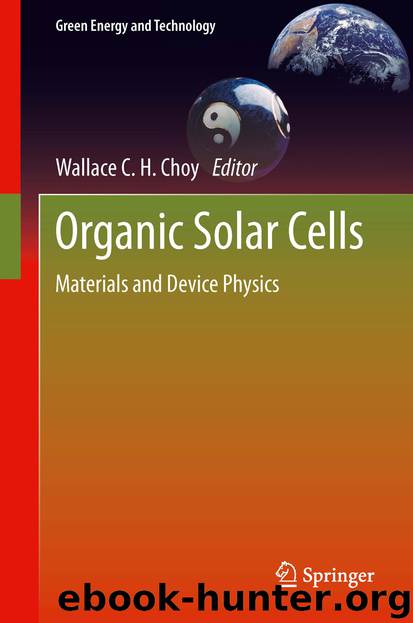Organic Solar Cells by Wallace C.H. Choy

Author:Wallace C.H. Choy
Language: eng
Format: epub
Publisher: Springer London, London
5.6.4 Relevance to Device Performance
As summarized in Table 5.1, we can evaluate all the efficiency of photovoltaic events in polymer solar cells. As described above, we can evaluate the efficiency of η ED, η CT, and η CD from the transient absorption study. The remaining charge collection efficiency η CC can be estimated from the internal quantum efficiency (IQE) reported in previous studies [57, 78–80]. Note that the efficiency is not absolute one but should depend on the film morphology. Indeed, the difference in the IQE is due to the different film morphology depending on the preparation conditions. Nonetheless, the efficiency listed in the table demonstrates which loss process is dominant in the device performance qualitatively. For RR-P3HT:PCBM solar cells, all the efficiency is more than 90 % after the thermal annealing. For RRa-P3HT:PCBM solar cells, on the other hand, the low efficiency in η CD and η CC is a major cause of the poor device performance. More specifically, the exciton diffusion η ED is ~100 % for RRa-P3HT:PCBM blend films, 93 % for RR-P3HT:PCBM blend films before the thermal annealing, and 89 % after the thermal annealing. In terms of the exciton collection to the interface, therefore, homogeneously mixed blend structures of RRa-P3HT:PCBM films are more desirable than phase-separated blend structures of RR-P3HT:PCBM films. This is consistent with the PL quenching results, indicating that there is still room to further improve the exciton diffusion efficiency in RR-P3HT:PCBM [81]. Indeed, such unquenched P3HT excitons can be effectively collected to the interface through the long-range energy transfer by loading appropriate dye molecules into RR-P3HT:PCBM blends [78, 82]. For the charge transfer at the interface, η CT is as high as ~100 % both for RRa-P3HT:PCBM and RR-P3HT:PCBM blend films, suggesting that it is dependent on the combination of donor and acceptor materials rather than blend structures. For the charge dissociation, η CD is as low as ~30 % for RRa-P3HT:PCBM blend films, while it is as high as 80 % for RR-P3HT:PCBM blend films before the thermal annealing and is improved to 93 % after the thermal annealing. For the charge collection, η CC is as low as 15 % for RRa-P3HT:PCBM blend films, while it is ~60–70 % for RR-P3HT:PCBM blend films before the thermal annealing and is improved up to >90 % after the thermal annealing. The large differences in η CD and η CC are mainly ascribed to the phase-separated networks and the crystallization of RR-P3HT, both of which result in improved carrier mobility and larger separation of bound radical pairs. The high charge collection efficiency is consistent with our conclusion in the previous section. In conclusion, there is not much difference in the charge generation yield between RRa-P3HT:PCBM and RR-P3HT:PCBM blend films. Rather, the charge dissociation and collection have a critical impact on the device performance of P3HT:PCBM solar cells. Further studies are required to address the origin of high efficiency in the charge dissociation and collection in polymer solar cells.Table 5.1Efficiency of each photovoltaic conversion event in P3HT:PCBM solar cellsa.
Download
This site does not store any files on its server. We only index and link to content provided by other sites. Please contact the content providers to delete copyright contents if any and email us, we'll remove relevant links or contents immediately.
Learning SQL by Alan Beaulieu(6166)
Weapons of Math Destruction by Cathy O'Neil(6090)
Digital Minimalism by Cal Newport;(5593)
iGen by Jean M. Twenge(5333)
Sapiens by Yuval Noah Harari(5268)
The Age of Surveillance Capitalism by Shoshana Zuboff(4126)
Elon Musk by Ashlee Vance(3993)
Thing Explainer by Randall Munroe(3854)
Apollo 8 by Jeffrey Kluger(3607)
Future Crimes by Marc Goodman(3467)
The Science Book (Big Ideas Simply Explained) by DK(3182)
Who Can You Trust? by Rachel Botsman(3064)
I Live in the Future & Here's How It Works by Nick Bilton(2907)
Infinite Energy Technologies by Finley Eversole(2900)
Steve Jobs by Walter Isaacson(2804)
Dawn of the New Everything by Jaron Lanier(2715)
The Innovators: How a Group of Hackers, Geniuses, and Geeks Created the Digital Revolution by Walter Isaacson(2709)
Chernobyl by Serhii Plokhy(2472)
Ben Franklin's Almanac by Candace Fleming(2429)
